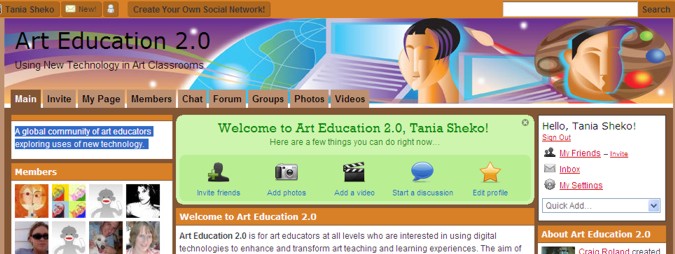Art Education 2.0 is a global community of art educators exploring uses of new technology.
Art Education 2.0 is for art educators at all levels who are interested in using digital technologies to enhance and transform art teaching and learning experiences. The aim of Art Education 2.0 is to explore ways of using technology to promote effective art education practices, encourage cultural exchanges and joint creative work, and support artistic projects, curricular activities, and professional development opportunities deemed important by our members.
When you sign up, you can avail yourself of all the usual socialnetworking options, for example, you can invite friends, upload photos or videos, or start a discussion. At a glance from the homepage you can see current projects, forum discussions and recent blog posts. The format is well organised and easy to read, eg. the post ‘Sir Ken Robinson & creative thinking’ , a post about Ken Robinson’s well-known TED talk, ‘Are schools killing creativity?’, is followed by several clearly displayed comments. I suppose, what I’m trying to say, is that it’s all there, and it’s easy and enjoyable to browse. A late night for me recently while I explored the blogroll – always dangerous to jump into hyperlinks, branching out evermore into oblivion.
New Web 2.0 resources in the right-hand navigation offer such delicacies as Andrew Douch’s video on the benefits of podcasting; Vizu, an interactive poll that can be added to a website or blog; 12 seconds, where you can record and share short videos about what you’re doing or where you are, etc.
On the left, there’s a chat option, featured websites, an option to share photos or videos, a section with a blog called ‘educational paradigms’, which includes posts such as ‘Keeping your teaching experiences fresh’, ArtsJournal , where you can check out daily art news, and more. You can also join groups, such as ‘first year art teachers’, or ‘Voicethread in the artroom’.
Digital art is popular with students, and teachers can get support for this by joining ‘Digital design’ . ‘Teaching animation’ supports teachers in a discussion of ideas, strategies, and tools for teaching animation.
I’ll definitely be telling my art faculty about this supportive art community. Makes me want to be an art educator!



